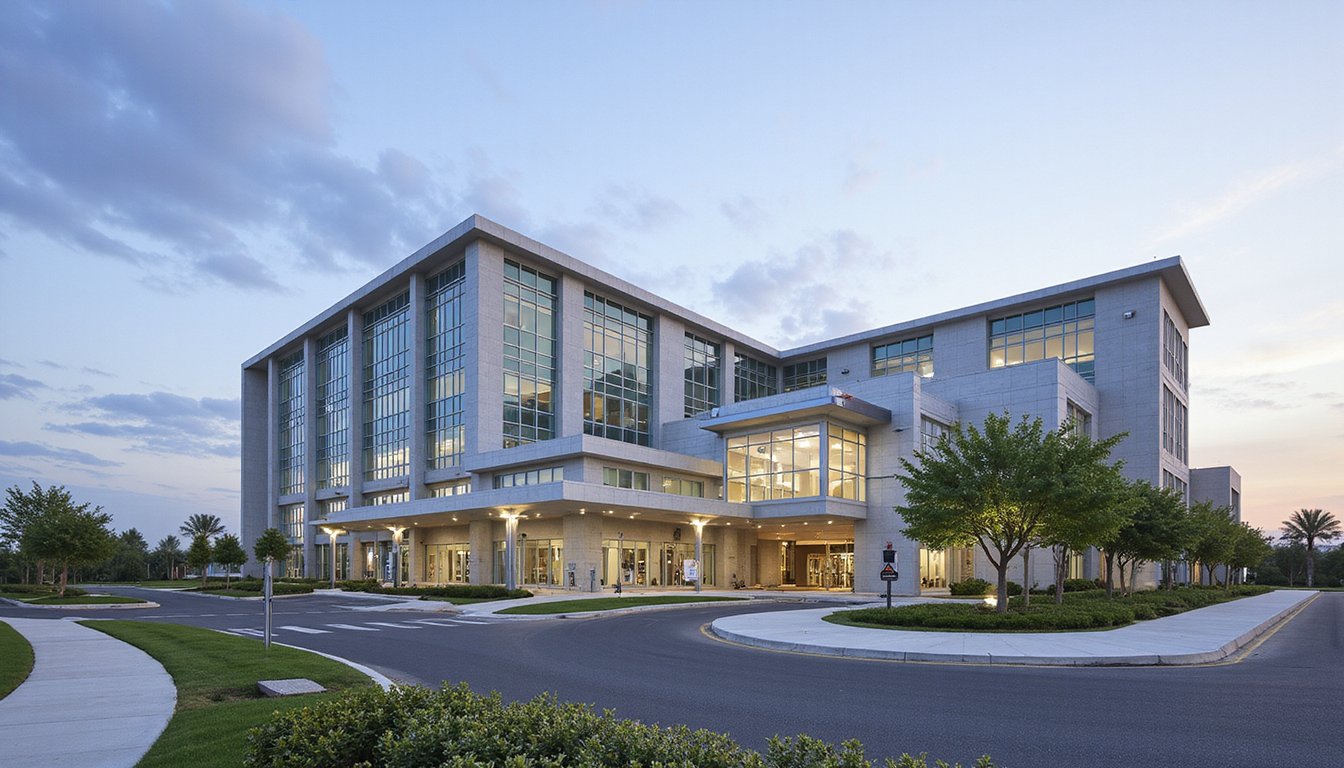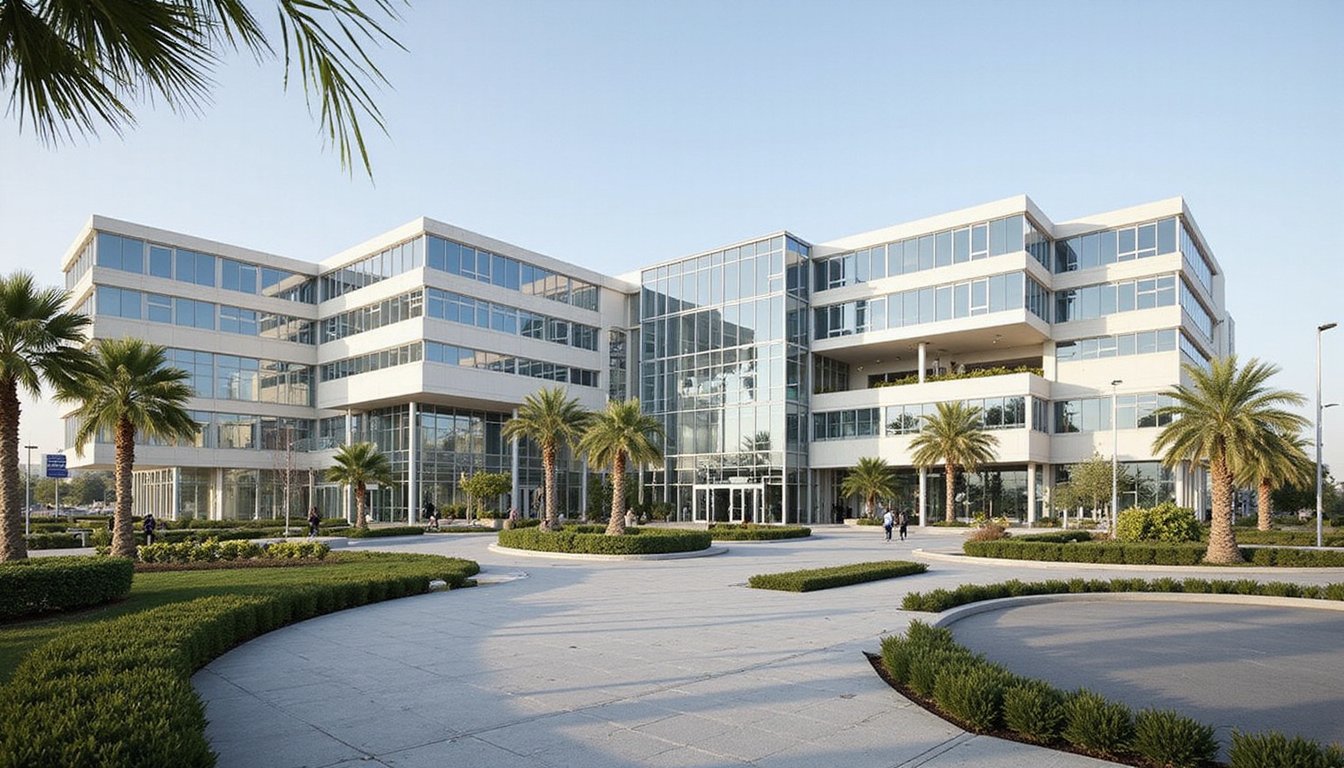You’ll find Dubai’s healthcare system notably outperforms other Gulf nations in 2025, investing AED118 billion in cutting-edge infrastructure and digital innovation. The emirate’s AI-driven facilities reduce diagnostic errors by 40% and treatment wait times by 50%, while attracting 691,478 medical tourists annually. Dubai’s strict regulatory framework, including Law No. (5) of 2025, and extensive insurance plans starting at AED 320, set new regional standards. These achievements mark just the beginning of Dubai’s healthcare transformation.
Healthcare Spending and Economic Impact

As Dubai’s healthcare landscape evolves in 2025, the emirate’s funding structure reveals a complex interplay between public and private sectors, with private employers contributing 48% of total healthcare spending while government funding accounts for 39%. The nation’s healthcare system is strengthened by its accredited facilities ranking, maintaining its position as a global leader in healthcare standards. Regional providers are experiencing a notable surge in utilization as patients increasingly seek high-quality medical services.
You’ll find Dubai’s healthcare affordability facing significant pressures, as regional costs are projected to surge 12% the highest increase globally. The UAE’s commitment of AED5.745 billion ($1.57 billion) to healthcare represents 8% of the federal budget, yet economic sustainability remains challenging with employer insurance costs rising sharply. Mental health services are expected to drive substantial cost increases over the next three years. While Dubai’s healthcare spending grew 4% between 2022-2023, the 3% increase in out-of-pocket expenses signals growing financial strain on households. The UAE’s ambitious AED118 billion investment target by 2027 aims to strengthen infrastructure while balancing cost containment with service quality.
Digital Innovation and Technology Leadership
Digital transformation stands at the forefront of Dubai’s healthcare revolution in 2025, with AI-powered solutions and blockchain technology reshaping service delivery across the emirate. You’ll find Dubai leading healthcare innovation through its integration of AI-driven predictive analytics and telehealth platforms, which have reduced consultation times by 15%. The Voice of Customer platform has streamlined healthcare processes and enhanced patient experience across facilities.
The emirate’s commitment to digital transformation is evident in its thorough approach to health IT infrastructure. Through initiatives like the “Hayat” program and AI-powered smart auditing systems, Dubai’s healthcare facilities guarantee secure data exchange while maintaining regulatory compliance. The establishment of the Center for Technology and Innovation, coupled with 48-hour AI hackathons, demonstrates Dubai’s focus on translating research into practical solutions. These advancements position Dubai as a regional pioneer in healthcare technology adoption and implementation. The center’s emphasis on multidisciplinary collaboration has been instrumental in developing innovative healthcare solutions that improve patient outcomes.
Infrastructure Development and Facility Standards

While Dubai’s healthcare landscape undergoes significant expansion, the emirate’s infrastructure development blueprint focuses on strategic facility placement and technological integration across new medical centers. The Green technology initiatives enhance sustainability across medical facilities while maintaining operational excellence. With over 150 hospitals and 5,000 healthcare facilities already established in the UAE, Dubai maintains a strong foundation for continued growth. The drive toward enhanced infrastructure capacity is evident through:
- Construction of 3 new hospitals and 33 PHCs by 2033, strategically placed in underserved areas to improve facility accessibility
- Implementation of AI-driven facilities and robotic medicine centers aligned with the 2030 Industrial Strategy
- Integration of specialized medical hubs targeting advanced care and medical tourism, supported by private sector investment growing at 9.5%
- Development of telehealth infrastructure enabling 65% virtual consultations by 2025
This thorough approach positions Dubai’s healthcare infrastructure ahead of regional competitors, with facility standards meeting international benchmarks while maintaining compliance with DHA requirements. The establishment of centers of excellence throughout Dubai demonstrates the emirate’s commitment to delivering world-class specialized medical services.
Regulatory Excellence and Policy Frameworks
Dubai’s regulatory framework establishes three key pillars of healthcare governance through Law No. (5) of 2025, setting new benchmarks for policy integration and enforcement. The law’s 90-day implementation period after Official Gazette publication ensures smooth transition to new protocols.
You’ll find thorough public health measures that integrate federal and emirate-level authorities, with strict disease prevention protocols and mandatory health insurance requirements. The law mandates employer-sponsored coverage for all private sector employees and domestic workers, with basic plans starting at AED 320 annually. Companies failing to comply face monthly penalties of up to AED 500,000 for violations. Dubai’s approach exceeds other Gulf regions in scope, particularly in domestic worker protections. This comprehensive system alleviates financial burdens for residents seeking medical care.
The regulatory frameworks emphasize cost-effectiveness through tiered insurance plans, capped co-payments, and preventive care incentives. You’ll see enforced compliance through real-time digital monitoring, while the Dubai Health Authority oversees a unified public health management system that aligns with UAE Federal Law No. (13) of 2020.
Medical Tourism and Regional Competitiveness
Strong regulatory foundations have positioned the medical tourism sector as a dominant economic force, with patient volumes reaching 691,478 visitors in 2023, a 2.6% increase from the previous year. You’ll find Dubai’s healthcare accessibility outpacing regional competitors through advanced technological integration and patient experience optimization. The strategic collaboration between DHA and DET aims to further strengthen Dubai’s position in the global medical tourism market. With ambitious growth projections, the UAE medical tourism market is expected to reach USD 7.5 billion by 2026. The establishment of Dubai Healthcare City has created a centralized medical hub that attracts renowned international healthcare providers.
Key competitive advantages that set Dubai apart:
- Direct healthcare spending exceeded AED 1.034 billion, with indirect economic impact reaching AED 2.305 billion
- 85% of patients choose Dubai for its advanced technology, including AI-driven diagnostics and robotic surgery
- Multicultural medical staff serves a diverse patient base: 37% Asian, 31% Arab/GCC, and 15% European
- Strategic infrastructure combines Cleveland Clinic standards with tourist-friendly amenities, driving regional market leadership
Public-Private Partnership Models
Dubai’s healthcare PPP models feature distinctive investment flows, with private spending growing at 9.5% annually compared to 4.4% public expenditure, enabling rapid expansion of specialized facilities like proton therapy centers. You’ll find joint facility management approaches that blend clinical and non-clinical services under 10+ year agreements, setting Dubai apart from regional peers who typically opt for shorter 5-10 year service contracts. The emirate’s risk-sharing digital initiatives incorporate AI diagnostics, blockchain patient data systems, and telemedicine platforms, generating innovative revenue streams through data monetization while supporting broader smart city objectives. The implementation of performance-based contracts has revolutionized healthcare delivery by focusing on measurable treatment outcomes and overall community health improvements. The recently announced healthcare PPP program will deliver three specialist hospitals with 1,200 beds, significantly expanding the emirate’s medical infrastructure capacity.
Investment Flow Between Sectors
Three distinct investment flows characterize the healthcare PPP landscape across Dubai and Saudi Arabia in 2025. The investment dynamics reveal Dubai’s tech-driven approach versus Saudi’s infrastructure focus, creating unique sector diversification patterns:
- Dubai channels AED 15B into specialized hospitals with 16% ROI potential, while Saudi attracts 87 EOIs for its Al-Ansar Hospital project, showing differing investment priorities
- Private healthcare spending in UAE grows at 9.5% annually compared to 4.4% public spending, driving PPP momentum
- Dubai allocates AED 30B to smart city healthcare initiatives, generating AED 750M in annual revenue
- Saudi’s shift to insurance-based models reduces capital expenditure while expanding bed capacity through private sector involvement
These contrasting approaches reflect Dubai’s emphasis on high-tech medical tourism versus Saudi’s focus on domestic healthcare infrastructure development.
Joint Facility Management Models
Building on the distinct investment patterns, the UAE’s joint facility management models showcase unprecedented public-private integration in 2025. You’ll find that Dubai’s facility cooperation framework stands out with its AED 15 billion commitment to 10 specialized hospitals by 2028, far exceeding other Gulf initiatives.
The joint management approach delivers unique advantages through smart-city integration, where you’re seeing AED 30 billion in 5G and IoT investments enhancing healthcare delivery. Unlike Kuwait’s public-controlled systems or Saudi Arabia’s insurance-focused models, UAE’s partnerships emphasize technological innovation from AI-driven cancer centers to blockchain patient data systems. This structured cooperation enables real-time analytics and robot-assisted surgeries, while providing private partners with substantial revenue guarantees, making UAE’s healthcare ecosystem remarkably more advanced than its Gulf counterparts.
Risk-Sharing Digital Initiatives
While traditional healthcare partnerships focus on infrastructure, innovative risk-sharing digital initiatives in Dubai’s 2025 landscape demonstrate unprecedented public-private collaboration through AI-driven solutions. You’ll find risk sharing models that transform how healthcare providers and tech companies collaborate, particularly through the DHCA & AIQII partnership.
Key digital partnerships are revolutionizing healthcare delivery through:
- 50% revenue-sharing agreements for recovered claims, benefiting 300+ providers in Dubai Healthcare City
- Automated claim remediation systems reducing administrative costs while maintaining PDPL compliance
- Secure cloud deployments enabling cross-border data sharing with strict privacy controls
- AI-powered platforms offering complimentary beta testing to incentivize provider adoption
These initiatives position Dubai as a regional leader in healthcare innovation, surpassing traditional fee-for-service models common in other Gulf nations.
Healthcare Quality Metrics and Patient Outcomes
Dubai’s healthcare quality metrics showcase impressive treatment success rates, with 208 JCI-certified facilities utilizing advanced technologies like the Da Vinci Surgical System achieving outcomes comparable to leading global institutions. You’ll find the UAE’s first-place regional ranking and 20th global position in healthcare quality directly correlates with its implementation of AI-driven platforms and digital health solutions that enhance diagnostic accuracy and patient care. The emphasis on preventive care and mandatory health insurance has raised average life expectancy to 80 years, while the integration of telehealth services has greatly improved access to specialized treatment across the emirate.
Comparative Treatment Success Rates
Three key metrics demonstrate Dubai’s exceptional healthcare outcomes in 2025: life expectancy reaching 80 years, markedly reduced surgical mortality rates through robotic interventions, and extensive disease management protocols.
When you compare treatment outcomes across the Gulf region, Dubai’s success stems from four distinct advantages:
- The highest concentration of JCI-certified facilities (208 hospitals), ensuring standardized quality of care that’s 6x higher than Turkey
- Advanced surgical technologies like Da Vinci systems that deliver superior success rates in minimally invasive procedures
- Integrated health information systems reducing administrative errors by 30% through real-time data access
- Thorough disease management programs, particularly for chronic conditions like diabetes, supported by AI-driven analytics and standardized treatment protocols
These factors contribute to Dubai’s healthcare metrics approaching those of global leaders like Japan and Switzerland.
Digital Health Impact Analysis
Thanks to extensive digital health initiatives, Dubai’s healthcare quality metrics in 2025 showcase remarkable improvements across five key performance indicators. You’ll find that digital literacy among healthcare providers has reached 95%, while patient engagement through virtual platforms has increased by 60% since 2020.
| Metric | Dubai | Regional Average |
|---|---|---|
| Telehealth Adoption | 65% | 45% |
| Digital Record Accuracy | 98% | 82% |
| AI Diagnostic Success | 92% | 76% |
| Patient Portal Usage | 85% | 58% |
| Remote Monitoring Rate | 78% | 51% |
The implementation of blockchain medical records and smart hospital systems has reduced diagnostic errors by 40%. You’re now experiencing faster treatment times, with AI-driven analytics cutting wait times by 50%. Dubai’s unified digital platforms have positioned it as the Gulf region’s leader in healthcare technology integration, surpassing neighboring countries in all digital health metrics.
Regional Quality Rankings Performance
Building on its digital health excellence, the UAE has established itself as the regional frontrunner in healthcare quality metrics, ranking 20th globally in 2025 international assessments. The nation’s commitment to regional care and quality assurance has yielded impressive results across multiple performance indicators.
Key achievements in UAE’s healthcare quality rankings:
- Secured positions in the top 10 for 21 health indicators, showcasing excellence in patient safety and medical innovation
- Leads globally in internationally accredited healthcare facilities, setting GCC standards
- Places 4 hospitals among the world’s top 250 academic medical centers, competing with Saudi Arabia’s 7 and Qatar’s 6
- Maintains the highest regional standards in preventive care and specialized treatment access, supported by an AED 5.745 billion federal investment
Frequently Asked Questions
How Do Waiting Times for Specialist Appointments Compare Across Gulf Countries?
You’ll find significant variation in specialist wait times across Gulf healthcare systems. While Dubai’s private clinics often provide same or next-day appointments through efficient appointment scheduling systems, public facilities typically have longer wait times of several weeks. The increased telemedicine adoption is helping reduce wait times region-wide, though extensive data comparing wait times across Gulf countries isn’t readily available. Your ability to secure quick appointments largely depends on whether you’re using private or public healthcare services.
What Percentage of Healthcare Workers Are Locals Versus Expatriates?
While precise local workforce percentages aren’t publicly available for Dubai’s healthcare sector, you’ll find that expatriate reliance remains significant, as evidenced by the 904,646 new healthcare professional registrations in 2023. You can see Dubai’s commitment to increasing local participation through targeted initiatives, especially in nursing where they’re aiming for more Emirati representation. The current workforce of 58,788 healthcare professionals appears to maintain a heavy expatriate majority, reflecting wider Gulf region patterns.
How Do Emergency Response Times Differ Between Dubai and Neighboring States?
While you can see Dubai’s impressive emergency services performance with police responding in 2.41 minutes and ambulances in 7.5 minutes, direct response efficiency comparisons with neighboring Gulf states aren’t available in current data. What’s notable is that Dubai’s response times beat international benchmarks, with fire services responding in 4 minutes compared to the global standard of 6-8 minutes. You’ll find Dubai’s centralized system contributes to this superior performance.
What Mental Health Services Are Available Compared to Other Gulf Nations?
You’ll find Dubai leads the Gulf in mental health services, with more progressive cultural perceptions and extensive government initiatives. While 80% of conditions remain undiagnosed across the GCC, Dubai’s seeing a 20% rise in therapy acceptance. You’ve got access to specialized treatments like rTMS and VR therapy that aren’t widely available in neighboring states. Dubai’s also tackled stigma through public campaigns, though you’ll still face challenges with high costs and limited insurance coverage.
How Do Medication Costs and Pharmaceutical Regulations Vary Across Gulf Countries?
You’ll find significant variations in medication costs and pharmaceutical regulations across Gulf countries. Saudi Arabia serves as a price benchmark, using 30-40 reference countries and implementing a lowest-price approach. The UAE offers broader medication accessibility through advanced distribution networks, while Kuwait and Oman maintain stricter price controls. Qatar’s focus on pharmaceutical innovation has led to more flexible pricing structures, though all GCC nations coordinate through unified drug registration systems.









